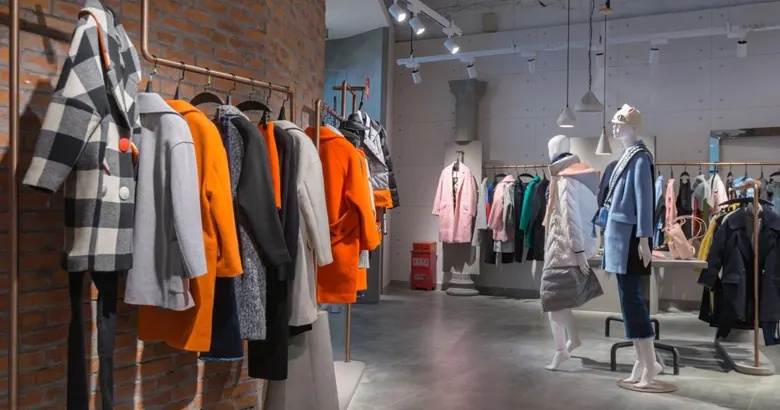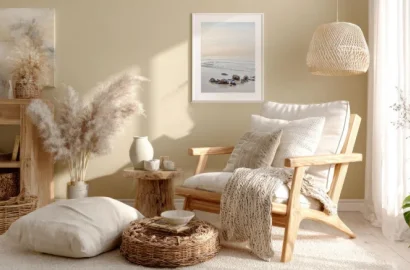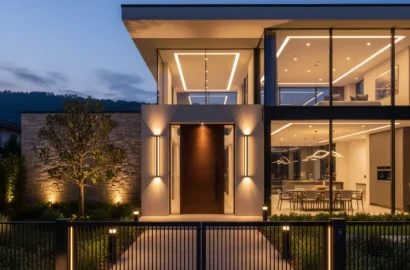Curious to find out about the latest trends in showroom design? We’ve got a host of creative ideas to draw in customers and make the most of your space whatever your product or budget.
Your showroom is one of your biggest customer-acquisition opportunities. Whether you’re selling cars, appliances, apparel, or furniture, this large retail space is where your potential customers can try out, interact with, explore, and evaluate your products before committing to a purchase. When guided by knowledgeable staff and interactive displays, this immersive brand experience boosts customer confidence while lowering rates of returns.
Getting the design of your showroom right is key to attracting and retaining customers. But how do you stand out from the competition, embrace new trends, and prioritize your customers’ needs? Through this article, we’re here to help. Come along for a compilation of the top showroom design trends for 2026 that you can use to create a modern, eye-catching, and user-centric retail environment. We’ve also got some easy-to-implement best practices that will ensure you get the design of your showroom right the first time and every time.
This is what we’ll be covering:
- Top ideas and trends to inspire your showroom redesign
- Best practices for designing your showroom
- Conclusion
Ready to learn more about creating an interactive and engaging showroom for your visitors? Then, keep reading!
Top ideas and trends to inspire your showroom design
What are the top ideas and trends that you need to know for your showroom design or redesign? Whether you’re showcasing furniture, bathrooms, cars, appliances, clothes, beauty products, or flooring, now’s a great time to modernize your product displays with some of these current trends.
1. Immersive digital experiences

Offline retail environments are increasingly incorporating immersive digital experiences into their interior design. By blending physical and virtual worlds in this way, showrooms become engaging and interactive spaces for visitors and customers.
Augmented reality (AR) and virtual reality (VR) are proving to be particularly on-trend for showrooms this year. A furniture showroom, for example, might use AR technology to let customers place a virtual dining table from the store’s collection into their own dining rooms. Similarly, a fashion outlet might enable customers to try on outfits using VR, saving them time in the changing room while helping them make informed, confident decisions.
The goal of incorporating immersive digital experiences into your showroom should always be to enhance the exploration and shopping journey of customers and visitors. Consider integrating AR mirrors or VR booths that support product or service interaction and provide additional information. Alternatively, you could develop a mobile app that enhances an individual’s journey through the store with visual customizations, product recommendations, special offers, and customer service support.
2. Sustainable materials
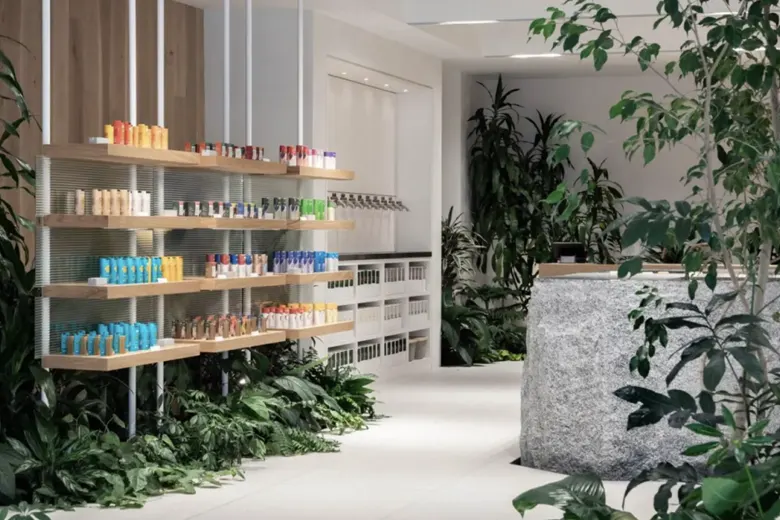
As businesses recognize the importance of embracing sustainable materials and circular retail trends to align with their eco-conscious customers, showroom designers too are responding to growing environmental concerns from the public by incorporating recycled, repurposed, and renewable materials into their designs.
Reclaimed wood, recycled metal, glass, and bamboo are just some examples of renewable and ethically sourced materials that can be used to create sleek, modern furniture designs, stylish shelving, and natural-looking displays. Natural fibers like wool and hemp are also great choices for upholstery, curtains, and rugs that help create a welcoming and warm feel for customers navigating your showroom.
While opting for sustainable, resource-efficient materials is important, prioritizing energy efficiency and waste reduction also play important roles when it comes to creating a fully sustainable showroom. Adopting low-energy lighting, smart climate controls, compostable packaging, reusable display units, dedicated recycling stations, and donating unsold products to local organizations are all fantastic ways of demonstrating your commitment to sustainability and your businesses’ eco-friendly credentials to customers.
3. Biophilic design
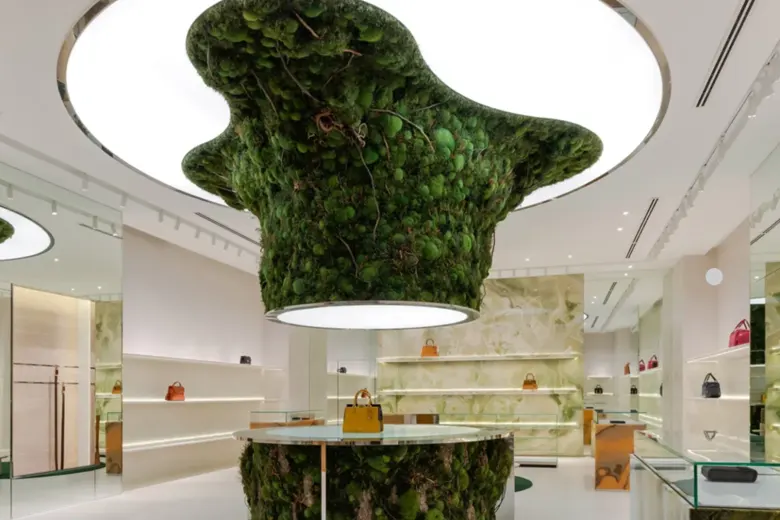
Biophilic design refers to when a space is designed to connect occupants more closely with the natural world with the intention of boosting health outcomes and increasing productivity. This design approach is typically achieved through direct and indirect inclusion of nature, and the optimization of space and place conditions.
Within a showroom or retail environment, biophilic design can be a great differentiator between brands. By designing spaces that incorporate natural lighting and ventilation, environmental landscape features, natural shapes, forms, patterns, and processes, a brand demonstrates its commitment to the well-being, creativity, and focus of its employees and customers. When carefully curated, a showroom that follows a biophilic design approach improves the customer experience while creating an environment that encourages mindful exploration and engagement.
Some biophilic design ideas for your showroom include:
- Incorporating indoor plants
- Maximizing daylight
- Using natural materials
- Integrating water features
- Installing furniture with soft curves and organic shapes
4. Personalized customer journeys

Personalized customer journeys are becoming increasingly sought-after by visitors to showrooms both on- and offline, a trend we are likely to see more of going forward. While personalization in-store may have previously been considered a “nice to have” for retailers, these days it’s something that customers have come to both desire and expect.
Through a personalized approach to the customer journey and experience, physical retailers can increase their chances of survival against the increasing threats of online retailers and discounters. By collecting and assessing aggregated proprietary data, showrooms can curate highly personalized customer experiences, setting them apart from competitors and helping them gain an advantage. A customer’s loyalty to a brand is also buoyed when close attention is paid to their specific needs and wants.
A customer-centric, data-backed approach is the key to delivering tailored customer experiences of all kinds. Some hands-on strategies you can implement in your showroom include:
- Using customer data to customize the showroom experience: By offering mobile apps or in-store tablets, a store can make personalized product recommendations based on a customer’s preferences and buying history.
- Building smart displays into the showroom: Smart displays and touchscreens allow customers to explore products in greater detail.
- Implementing customer-specific product displays: Create dedicated product displays or zones that cater to specific customer groups based on demographic data.
- Offering personalized in-store events or experiences: For example, a furniture showroom might offer personalized design consultations for customers seeking help designing their homes
5. Modular and flexible display structures
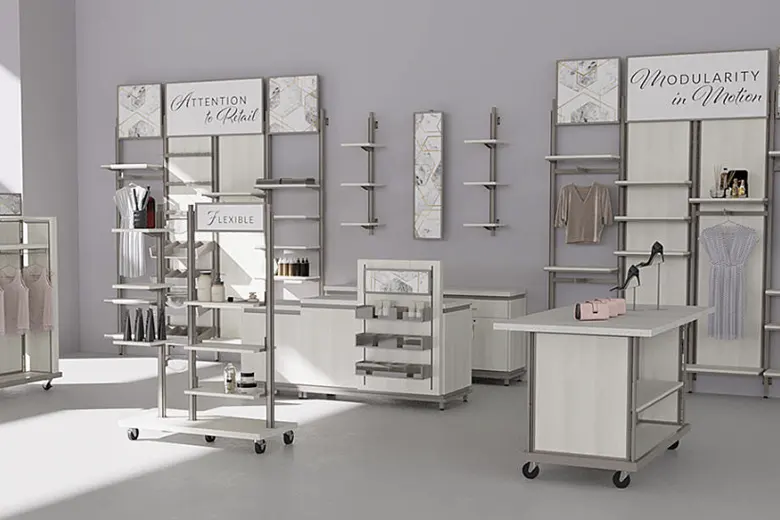
Modular display structures and layouts solve many of the headaches of modern showroom design and functionality, facilitating changing product lines, seasonal collections, and evolving customer preferences while encouraging more creativity in the space.
Showroom employees can stay ahead of market trends more easily too, solve accessibility problems faster, and keep the look of the room fresh and modern irrespective of season or promotion. In contrast to more traditional, static designs that can quickly feel outdated, modular and flexible display solutions create a dynamic customer-centric environment that feels instantly appealing.
Let’s take a look at some examples of modular and flexible display structures for different industries.
In the fashion industry:
- Flexible racks
- Adjustable garment displays
- Customizable lighting
In furniture showrooms:
- Reconfigurable shelving
- Adjustable tables
- Movable partitions
In tech showrooms:
- Adjustable lighting
- Customizable wall units
- Extendable tables
6. Customizing products with Augmented Reality (AR)
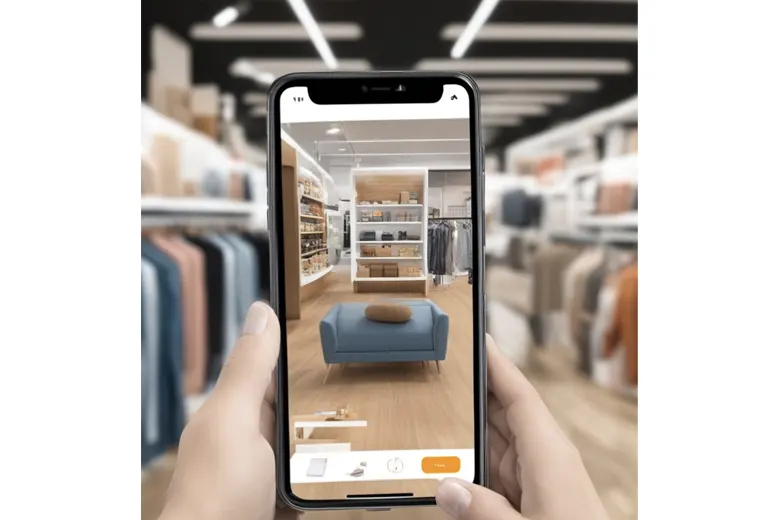
AR technology is a highly efficient tool to enhance how customers interact with products and displays in a showroom environment. This is because, by overlaying digital content onto a physical space, customers can visualize, explore, experiment with, and customize products at will, experiencing them in ways that give them more information about their potential purchase. This interactive and immersive shopping experience offers showroom teams an exciting opportunity to display products, boost customer engagement, and ultimately increase purchases. It also reduces the number of returns and exchanges, as customers feel more confident in their purchases when making them.
There are numerous ways that AR can be used to enable and enhance product customization in a showroom.
- Enables the visualization of different variations of a product (shape, color, size, texture, material, features, and more.)
- Enables customers to see how a product will look and fit in their chosen environment
- Provides real-time customization and feedback
- Allows customers to interact with 3D models of products, providing a more immersive and detailed understanding of a potential purchase
7. Clean lines and open spaces
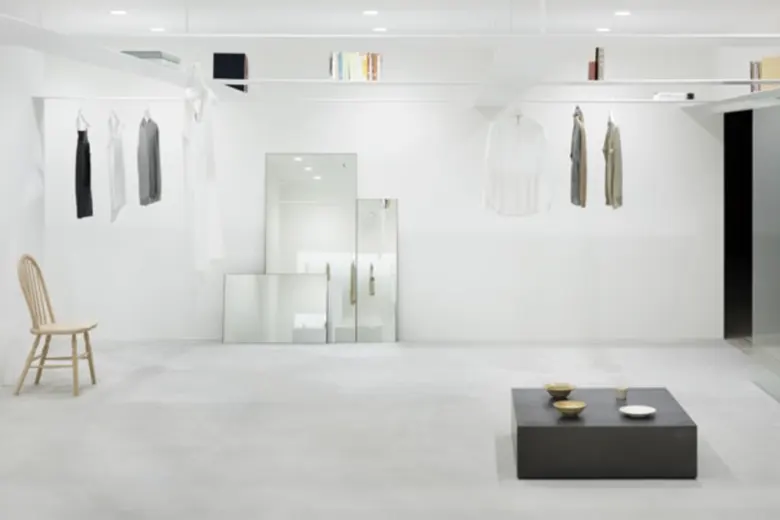
Unlike traditional retail environments that can feel busy and even cluttered, trends in showroom design in 2026 point towards a more minimalist aesthetic, giving products the room they need to shine while offering customers a calm, spacious, and inviting environment to explore.
By focusing on simplicity, clarity, and functionality, showroom teams can create distraction-free spaces in which customers engage with products and members of staff at their own pace. Minimalist spaces embody a sense of freedom that facilitates seamless product interaction and active contemplation. Another advantage of incorporating clean lines and open spaces into your showroom is that it gives potential customers the headspace and breathing room to fully deliberate their purchasing decisions. They can visualize how products might fit into their lives or homes without feeling rushed into making a decision or overstimulated by elaborate decoration or too many options.
To achieve this modern and serene look in your showroom, hone in on sleek, straight-edged furniture, plenty of floor space, and geometric shapes that bring a sense of order to the room. Avoid unnecessary or excessive decoration as this can distract from your products which should take center stage. Where possible, take advantage of large windows, high ceilings, and strategic lighting to further enhance the sense of space and openness.
8. Hybrid showrooms
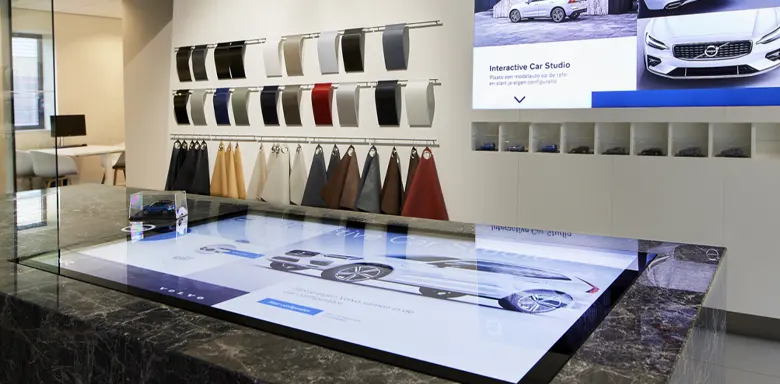
A hybrid showroom refers to one that combines both physical and digital experiences. Proving to be a game-changer in the retail industry, hybrid showrooms aim to bridge the gap between in-store and online shopping, enabling customers to choose their preferred style of interaction, exploration, and purchasing. By integrating interactive technologies like AR, VR, and touchless interfaces, showrooms can optimize and improve the shopping experience for customers who can fully immerse themselves in the shopping experience before making a purchase.
Examples of how a hybrid showroom might work include:
- Incorporating AR into a showroom allows customers to visualize how products will look on themselves or in their home
- Offering digital kiosks that provide more detailed product information, special offers, reviews, and comparisons
In addition to these digital experiences, technology can enable customers to engage in sensory experiences with products in the physical showroom. They can see, touch, feel, listen to, and try out products in person to get a real feel for the item they are thinking of buying. These in-person experiences foster deeper emotional connections with the brand while also building trust as customers know exactly what they are getting when they make a purchase.
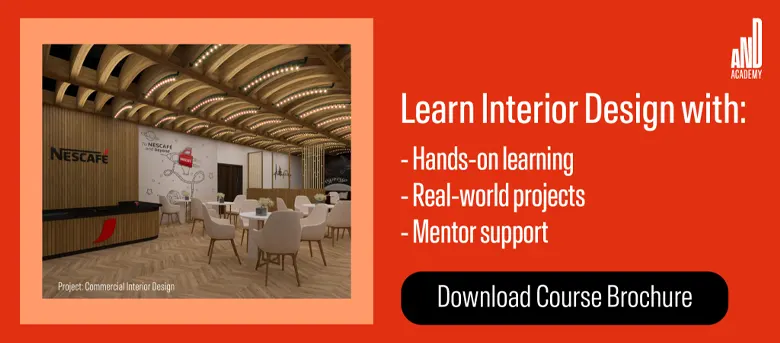
Best practices for designing your showroom
These are our best practices to ensure your showroom attracts and retains customers while ensuring a positive and seamless experience.
1. Make your showroom eye-catching.
Making your showroom a tranquil environment that encourages customers to explore doesn’t mean it needs to be dull. To grab the attention of visitors, consider incorporating striking and innovative displays that show your products in their best light.
Consider trying out some of the following ideas:
- Experimenting with bold colors on walls and furniture
- Using interesting textures for carpets or upholstery
- Arranging your displays to align with a theme
- Incorporating statement design pieces
- Building digital displays
By being playful with your showroom’s design you can make a memorable first impression that encourages further investigation and interaction.
2. Keep the design simple.
A simple showroom design allows your products to speak for themselves. While a vibrant interior design and layout can support this goal, it’s important that it does not detract from the goods on display–these should take center stage.
With clean lines and clear pathways, you can more easily avoid clutter and minimize distractions while ensuring the whole room feels open and ordered. A simple design is easier for customers to navigate too, facilitating a shopping experience that’s overall more enjoyable and successful.
3. Align your aesthetic with your brand.
The style and design of your showroom should be a natural extension of your brand’s identity and values. This alignment with branding enables customers to not only recognize and identify with your brand more easily but also helps them to mentally connect their online and offline experiences.
When brands fail to align their physical presence with their digital one, customers can get confused and even lose trust in the company. For this reason, it’s important your brand imagery, logos, color schemes, typography, and promotional materials align across all digital and physical environments.
4. Tailor to your target audience.
As any designer will tell you, knowing your target audience is the key to a successful design. This is also true of a showroom or retail space. By understanding your core customers, you can design a showroom that meets their needs, preferences, and shopping habits. The more you research your target audience and apply your insights to the design of your showroom, the more effectively you will boost customer satisfaction and increase the likelihood of making a sale.
Conclusion
We hope you’ve enjoyed our run-through of showroom ideas, trends, and best practices for 2026. If you’re looking to stay ahead of your competitors and capture the imagination of your target customers this year, integrating interactive technologies, creating a personalized shopping experience, and opting for sustainable yet flexible display solutions in your showroom will be crucial. By adopting a customer-centric approach that integrates flexibility and personalization while celebrating clean open spaces, your showroom can become an environment that not only attracts visitors but also builds lasting connections with customers.
If you’d like to discover more about Interior Design, consider the following resources
- Everything You Need To Know About Residential Interior Design (With Ideas)
- A Comprehensive Guide To Minimalist Interior Design And How To Make The Most Of It (With Ideas)
- A Comprehensive Guide to Modern Interior Design (With Ideas)
Next Steps
If you enjoyed this article and would like to learn more about interior design, head back to AND Academy’s blog for more articles like this one. We also recommend you check out this project by AND Learner, Pawanjot Singh to get inspiration for your next interior design project.
In case you need further assistance, here are some resources to consider:
- Watch this session by Snehanshu Mukherjee, Founding Partner at T.E.A.M and Mansi Almadi, an Interior Designer at Studio Lotus
- Talk to a course advisor to discuss how you can transform your career with one of our courses.
- Check out our Interior Design courses – all courses are taught through live, interactive classes by industry experts.
- Take advantage of our scholarship and funding options to overcome any financial hurdle on the path of your career transformation.
Note: All information and/or data from external sources is believed to be accurate as of the date of publication.

